Go Boom - Double Deck: This game can also adapt very well to larger numbers of players. The double deck version is great for 7 to 12 players. This game uses two standard 52 card decks shuffled together.
The game is played identically to the standard game save for the larger number of players and larger number of cards comprising the deck. As in the standard game, when two or more cards tie for the highest card played to a trick, the first of these cards played is considered to have won the trick.
Reverse Scoring: Some players prefer to use a reverse type of scoring system when playing Go Boom. In this variant, at the end of each hand, each player must add to his own score the point value for the cards remaining in his hand. At such time as any player reaches or exceeds a total of score of 100, the game ends. The player at this time who has the lowest total score is declared the game winner. In case of a tie for lowest score, the tying players are declared co-winners. In all other respects this version is played identically to the standard version described above.
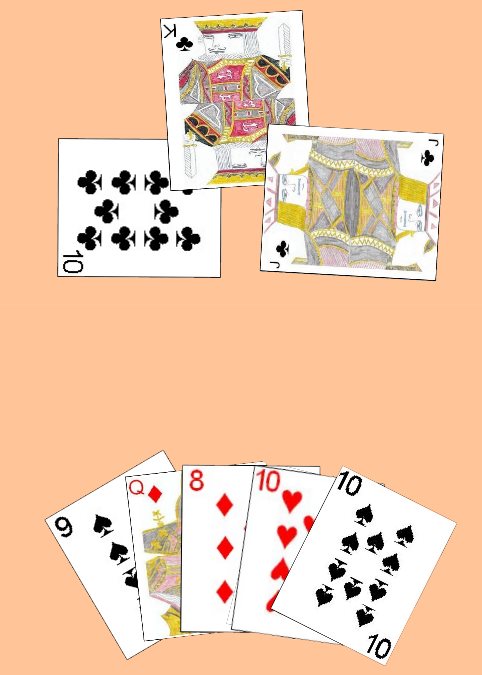 Enflé
Enflé: Enflé is another fun game which combines the winning of tricks with the attempt to be the first player to run out of cards. This game also goes by the names Schwellen and Rolling Stone.
The number of cards used is directly dependent on the number of participants in the game. The game can be played by a maximum of 6 players. The following chart shows the cards which should be removed from one standard deck dependent on the number of participants in the game.
| Number of Players | Cards Removed from Deck |
|---|
| 4 | All twos, threes, fours, fives, and sixes from the deck |
| 5 | All twos, threes, and fours |
| 6 | All twos |
Seating positions and first dealer can be determined in a number of ways, with drawing for high cards a common method. The players select seat in the order from highest to lowest card drawn. If two or more players tie for lowest card, those players should draw additional cards until no tied cards are drawn. The player who draws the lowest card of all is set as the first dealer. After each hand, the deal rotates in a clockwise rotation.
After the deck has been reduced as indicated by the chart above, the dealer shuffles the cards and begins dealing the cards one by one and face down in a clockwise rotation, starting with the player to his immediate left. He continues dealing until the entire deck has been dealt out to the players. Each player should end up with eight total cards. After completion of the deal, the players then pick up their cards and examine their hand.
The player to the immediate left of the dealer plays the first card to the first trick which may be any card from his hand. Each subsequent player in a clockwise rotation then plays one card to the trick. If the player has a card of the suit led to the trick he must play it. If he does not have such a card he must take up all cards currently on the table, previously played to this trick and add them to his hand. In this case the player taking the cards may then start a new trick playing any card from his hand. If all players are able to play a card of the same suit to the same trick, the player who played the highest card of the suit led to the trick wins the trick. That player sets the trick aside and out of play and starts a new trick, playing any card from his hand.
The first player to play the last card from his hand is declared the winner of the game.
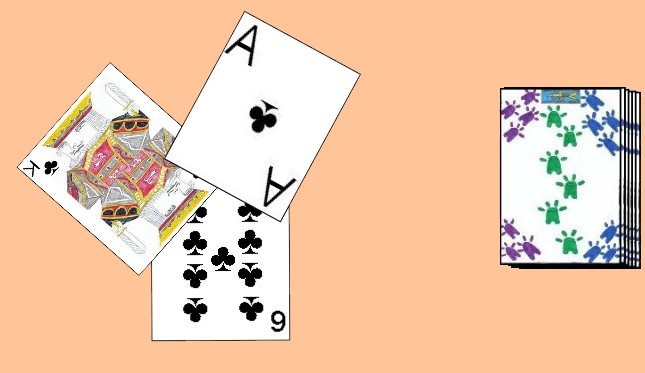 Page One
Page One: Page One is a Japanese game which bears
several similarities to Go boom and Enflé. Page One is designed to be played by two to four players using one standard 52 card deck and one Joker. The ranking of the cards in the deck are as follows (from high to low): Joker, Ace, King, Queen, Jack, 10, 9, 8, 7, 6, 5, 4, 3, 2.
Determination of seating positions and the first dealer can be performed in a variety of methods, with draw for high cards a common method. Once all the players are seated and the first dealer selected, this first dealer thoroughly shuffles the deck and offers it to the player at his right to cut. After the cut the dealer begins dealing the cards in a clockwise rotation around the table, starting with the first player at his left. He continues dealing the cards one at a time, until each player, including himself, has four face down cards. He then places the remainder of the deck face-down in the center of the table to form the stock pile.
The player to the immediate left of the dealer leads to the first trick. He does this by selecting any card from his hand and playing it to the center of the table. Each other player in a clockwise rotation then plays a card from his own hand to the trick. A player may only play a card of the same suit as was originally led to the trick. If a player does not have a card of that suit, he must draw cards one by one from the stock until he draws a card of that suit that he then plays to the trick,
ending his turn. After each player has played one card to the trick in
turn, the trick is won by the player who played the highest card of that suit to the trick. That player then sets the cards from that trick aside, into a discard pile and begins the next trick by leading any card from his hand.
The only exception to the requirement that a player play a card of the same suit as led to the trick is in the case of the Joker. A Joker can be played to any trick and will always be considered the highest card, winning any trick to which to which it is played. If the Joker is the lead card to a trick, the next player in turn may play any card from his hand to that trick, and each other player must then play a card of that suit. However, the Joker will still automatically win that trick.
The game continues until one player has played his last card on his turn, after which he is declared the winner of the game. When a player plays a card to a trick, reducing his hand to exactly one card, that player must loudly state "Page One". He must do this before the next play. If he fails to do so
and this is noticed by any other player, the player with the one card must draw five cards from the stock as a penalty.
If the stock pile runs out of cards during play, the used discard pile is reshuffled and placed face-down in the center of the table to form a new stock pile. If it comes about that the stock pile has been depleted, there is no remaining discard pile and a player is required to draw, the game instantly ends in a draw, with no clear winner.
Bhabhi: Bhabhi is a game from India which
follows some similar concepts as other card games described on this
page. Although the word Bhabhi is a term used to indicate a familial association (one's brother's wife)
in the Punjabi language, the word can sometimes be used in a very derogatory manner,
thus the game is also often called by it's alternate name Getaway, which describes the game well.
The ranking of the cards as used for this game are as follows (from highest to lowest): Ace, King, Queen, Jack, 10, 9, 8, 7, 6, 5, 4, 3, 2. The game can be played by three to eight players, although there are variants for two players and for more than eight.
Determination of seating positions and first dealer can be performed
using a variety of methods, with draw for high cards common. After each
hand the role of dealer rotates around the table in a clockwise
direction. Once the players are seated and the dealer determined, the
dealer should thoroughly shuffle the deck and offer it to the player at
his immediate left to cut. After the cut, the dealer should begin
dealing the cards in a clockwise direction around the table, dealing out
the entire deck. Some players may receive one extra card than others
which is acceptable.
The object of the game is not to be the last player in a hand still holding cards. To that end, the game is played in a series of tricks.
The first trick of the hand is played somewhat differently than the others. The player who holds the Ace of Spades in hand starts this first trick, playing that card face-up to the middle of the table. Each other player than also plays a card in the suit of Spades face-up to this same trick. If a player has no cards in the suit of Spades, he may play any card of his choice to the trick. Normally, the players play in turn, but on this first trick, since the Ace of Spades will always win the trick, the players may play in any order. After each player has played one card face-up to the trick, the trick is gathered up and set aside face-down out of play in a waste pile.
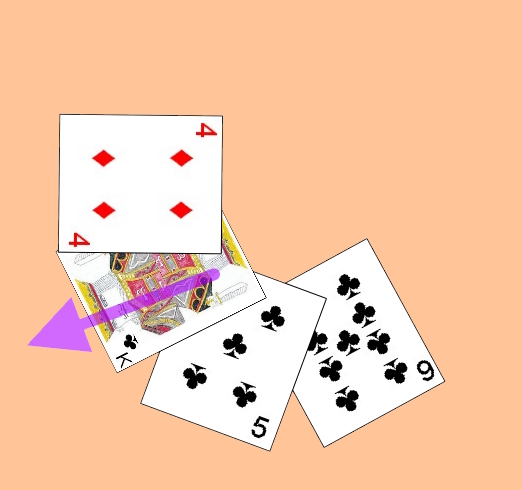
For the second and subsequent tricks, the winner of the previous trick begins play by selecting any card of choice from his hand and placing it face-up in the middle of the table to start that trick. On the second trick, this trick will be started by the player of the Ace of Spades from the previous trick, since that would be
the winning card from the first trick. After the leader to the trick plays the first card the turn rotates in a clockwise direction from that lead player. If a player has one or more cards of the suit originally led to the trick, he so must play a card of that suit to the trick, face-up. However if the player does not have a card of that suit, he can play any card from his hand to the trick (called tochoo), also face-up. In the event a player does play a card of a different suit, play to that trick immediately halts. Whichever player played the highest card of the suit originally led to that trick then takes all cards which have been led to the trick into his hand (including the card of a different suit). Note that, because play to that trick was halted, not every player may have played a card to that trick. The player of that highest card (the winner of that trick), then begins play to the next trick, leading any card of choice from his hand. If all players managed to play a card of the suit originally led to the trick, no player is required to take those cards into his hand, and the cards from that trick are added face-down to the waste pile. The player who played the highest card to that trick is considered the winner of the trick and begins play to the next trick, leading any card of choice from his hand.
If a player manages to play the last card from his hand, he is said to have gotten away and drops from the game. However, if that player was actually the winner of the trick he may not be able to so get-away. If the play was halted by play a card of a different suit played to the trick he must of course take the cards from the trick into his hand. If, on the other hand, everyone was able to play a card of the same suit to the trick, if the player who has run out of cards is the winner he is still considered to be in the game, and thus must still lead a card to the next trick. Thus, in order to obtain a card to lead to the next trick, this player has two options.
- The first option this player has is to draw a random card from the waste pile. If selecting this option, the waste heap is shuffled and left face-down. The lead player then draws one card from this shuffled pile, leading that card to start the next trick. The waste pile should be shuffled and the player draws his card before the cards from that last trick are added to that waste pile, however.
- The second option is to randomly select one card from any other player of his choice. If selecting this option, the player whom this player selected must fan his cards face-down on the table and the lead player takes any card from the formation. He then uses this card as the lead to start the next trick.
If this player again wins the next trick, and has no cards, he will have the same options for obtaining a card to lead to the next trick. Once a player does play his last card and is not required to take the pile or lead to the next trick, that player has safely gotten away and drops from the hand. The game continues in this way until all but one player remain in the game, with the last player still retaining cards considered the loser of the game.
During the game, before play to a new trick starts any player may elect to take all cards from the closest player to his immediate left who still has cards. He thus adds these cards to his own hand and the player from which the player took the cards has gotten away and drops from the hand.
If the game is to be played by more than eight, a double deck should be used for the game which are thoroughly shuffled together. However, the Ace of
spades from one deck should be removed before play begins. If there is a tie for who won a particular trick (due to the highest card to the trick having been duplicated) the first such card played to the trick is considered the higher and thus the winner of the trick.
If any player plays out of turn during (except during the first trick) or plays a card to a trick after that trick has been halted (by a tochoo), the player who played that card must take the cards from that trick instead of the player who normally would have won the trick. The winner of that trick, however, is still required to lead the first card to the next trick.
Burro: Burro is a Spanish game of the
inflation family of card games. Burro should not be confused with a
different game which is also sometimes called Burro or
Donkey. Burro can be played by 2 to 8 players, and, being from Spain, is traditionally played using a 48 card Spanish suited pack. This pack consists of 12 cards in each of the four suits consisting of coins, glasses, clubs, and swords. Each suit contains one card each in the ranks of 1 (Ace), 2, 3, 4, 5, 6, 7, 8, 9, Maid (Queen), Horse (Jack), King. If such a deck is not at hand for play, a standard 52 card international deck can be used in which the tens have been removed. The ranking of the cards in this deck would then be as follows (from highest to lowest): King, Jack, Queen, 9, 8, 7, 6, 5, 4, 3, 2, Ace.
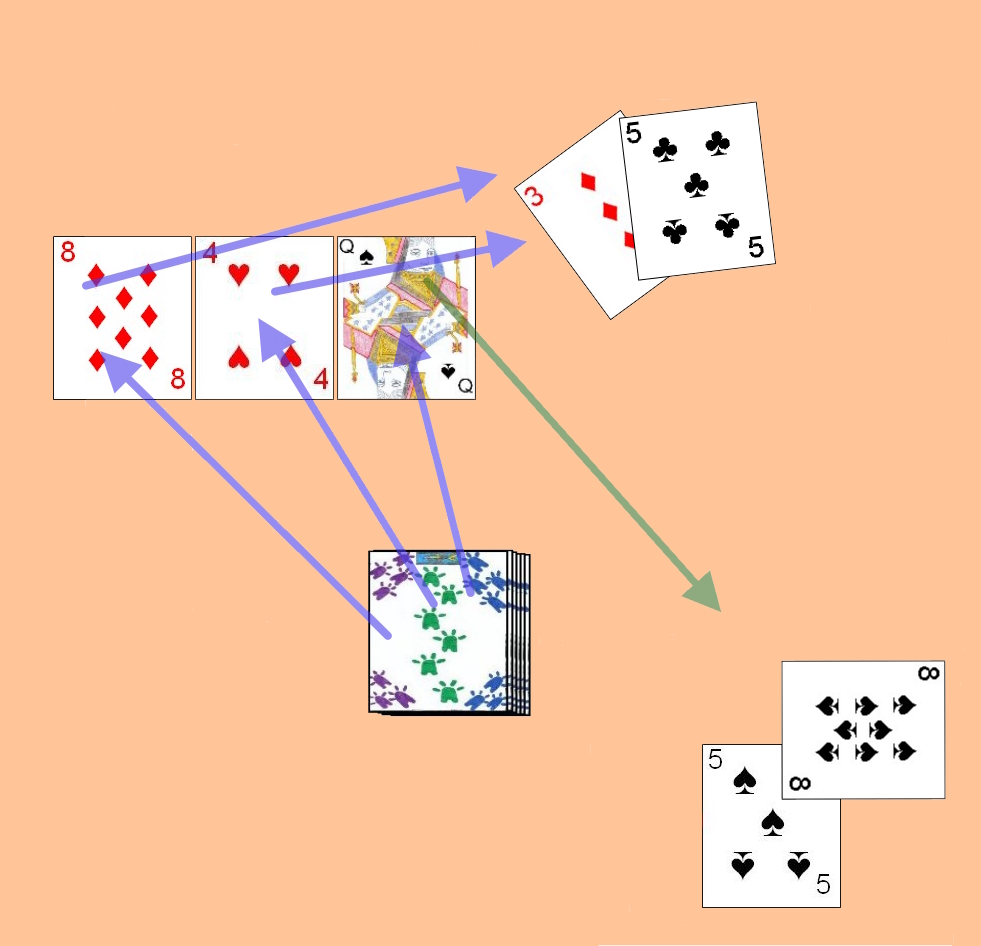
Determination of seating positions and the first dealer can be performed using a variety of methods, with draw for high card a common method. Players would each randomly draw a card from the shuffled deck, and take seats at the table in order of cards drawn, from highest ranking to lowest. Any players drawing cards of equal rank would discard those cards and draw again, continuing to redraw if drawing a card that has already been previously drawn by another participant. The player drawing the highest card of all is set as the first dealer. After each hand the role of dealer rotates around the table in a counter-clockwise direction.
Once the first dealer has been determined, this player would then thoroughly shuffle the deck and offer the deck to the player at his immediate left to cut. After the cut, the dealer then begins distributing the cards around the table in a counter-clockwise rotation around the table, starting with the player at his immediate right. He deals the cards one-at-a-time and face down in front of each player, continuing this deal until each player has a total of four cards. He then places the remainder of the deck face-down near the center of the table as the stock pile.
The player to the immediate right of the dealer leads the first card to the first trick, with the turn rotating in a counter-clockwise rotation around the table with each player playing one card to the trick.
The leader to a trick may play any card remaining in his hand to start the trick. Each other player, in turn, must then play a card of the same suit as led to the trick if able. If he has no cards of that suit in his hand, he must draw cards, one-by-one, from the stock until he draws a card of the suit led to the trick, which he then must play to the trick. If there are no remaining cards in the stock pile, he does not draw additional cards and simply passes his turn to the next player in rotation.
After each player has played a card to the trick (or passed in the event that the stock is exhausted and the player has no cards of the trick's required suit), it is determined who has won the trick. The player of the highest card to the trick is considered the winner of the trick. The cards from the trick are set aside, face-down and out of play. The winner of each trick
then leads the first card to the next trick. If the winner of the trick has no cards remaining (thus dropping out of the hand), the leader to the trick will be the player, of those who still have cards remaining in the hand, who had played the highest card to that last trick.
Once a player legally plays the last card from his hand to a trick, he drops from the hand, as one of the winners. This continues until only one player remains in the hand with cards, who is considered the loser of the hand. That player earns one penalty point. A new hand is then dealt by the next dealer in turn.
The game continues until one player reaches an agreed total number of penalty points, at which that player is considered the loser of the game.
Burro Deitado: Burro Deitado is one of two versions of Burro that is commonly played in Portugal. Burro Deitado is played very similarly to the standard game with the following differences:
- The game is played using the smaller 40 card Spanish pack. This deck consists of 10 cards in each of the four Spanish suits. Each suit thus contains cards in the denominations of 1 (Ace), 2, 3, 4, 5, 6, 7, Maid (Queen), Horse (Jack), King. This deck can be created from a standard 52 card International deck by removing all cards of denomination 8, 9, and 10. The ranking of the cards as used in this game is, from highest to lowest; King, Horse (Jack), Maid (Queen), 7, 6, 5, 4, 3, 2, 1 (Ace).
- Each player is dealt five total cards to start each hand.
- A player may, even if he has one or more cards in the suit of the card originally led to the suit which he could play, elect to draw cards from the stock.
In all other aspects Burro Deitado is played identically to Burro as played in Spain.
 Burro em Pé
Burro em Pé: Burro em Pé is the other common Portuguese variant of Burro. Similar to Burro Deitado, Burro em Pé is played very similarly to Spanish Burro with a few differences:
- This variant is played using the 40 card Spanish pack. Each suit thus contains 10 cards in each of the normal Spanish suits, in the denominations of; 1 (Ace), 2, 3, 4, 5, 6, 7, Maid (Queen), Horse (Jack), King. The deck used for the game can also be created from a standard 52 card International deck by removing all cards of denomination 8, 9, and 10. The ranking of the cards used in this game is, from high to low; King, Horse (Jack), Maid (Queen), 7, 6, 5, 4, 3, 2, 1 (Ace).
- The dealer distributes five cards to each player at the start of each hand.
- After the cards have been dealt, the dealer splits the remainder of the deck into two halves, then leans the two halves against each other to form an inverted V structure, which is the stock pile.
- Even if a player has a card of the required suit in hand, he may still elect to draw cards from the stock pile into his hand.
- In drawing a player draws from either of the two halves of the stock pile structure, one card at a time. If a player, in drawing (or at any other time), causes the stock pile to fall over or topple, that player must take all the cards from this stock pile into his hand.
- Each hand is a complete game, with the first player to run out of cards declared the game winner.
Other than these differences Burro em Pé is played identically to standard Burro as described further above.
Cangkul: Cangkul is a similar game from the inflation family of games which is commonly played in Indonesia. The name of the game, Kangkul translates to digging (such
as using a garden hoe to dig up weeds). The game is sometimes played under the name Minuman, or, if played in India, in the state of Goa, under the name Donkey. The game is designed for play by 3 to 5 players and uses one standard 52 card deck. The ranking of the cards as used in this deck is as follows (from high to low): Ace, King, Queen, Jack, 10, 9, 8, 7, 6, 5, 4, 3, 2.
Determination of seating positions and first dealer can be performed using a variety of methods, including draw for high cards. Using that method, each player draws a card from a face-down shuffled deck. Any players drawing cards of equal rank discard those cards and draw a new card, continuing to draw until drawing cards of a distinct rank, not previously drawn by any player. The players then take their preference of seats in order from highest card drawn to lowest. The player drawing the highest card of all is set as the first dealer. After each hand, the deal rotates in a clockwise direction around the table.
The dealer for each hand first thoroughly shuffles the deck and offers it to the player at his right to cut. After the cut, the dealer begins dealing the cards in a clockwise rotation around the table, starting with the player at his left. He deals the cards one-by-one and face-down, continuing in rotation until each player has a total of seven cards. He then places the remainder of the deck face-up in the middle of the table as the stock pile. The player to the immediate left of the dealer leads the first card to the first trick, with each player in turn playing to that same trick.
The leader to a trick may play any card still remaining in his hand to lead the trick. Each other player, in a clockwise rotation then plays a card of that same suit to the trick. If he has no such card, he must draw cards, one-at-a-time from the stock until he receives a card of that suit, which he then must play to the trick. This continues with each player playing an appropriate card to the trick (and drawing from the stock if necessary). The highest card played to the trick wins the trick, and the player of that card leads the next card to start the next trick. Cards from won tricks are set aside and out of play for the remainder of the hand.
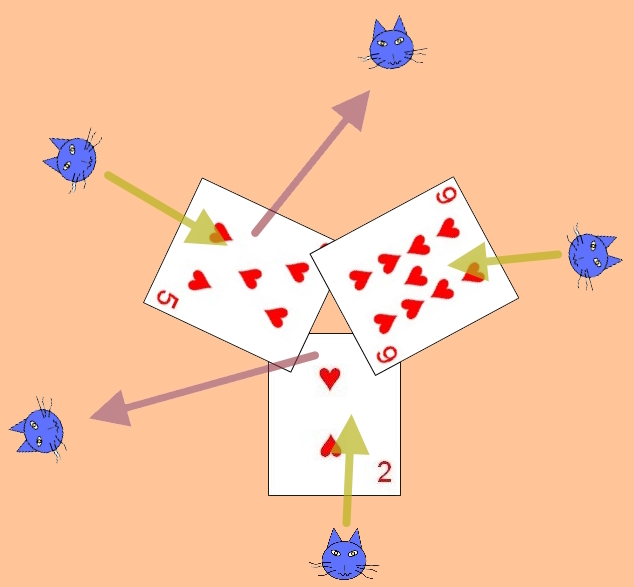
If a player is unable to play a card to the trick and there are no more cards in the stock to draw, that player simply skips his turn, with play advancing to the next player in turn. However, after the other players have played to the trick, the player unable to play to that trick must take all the cards from the trick and add those cards to his current hand. If there were two or more players unable to play a card to that trick, after the trick has been completed by the other players,
the players unable to play a card to the trick must then, each in turn, starting with the first player unable to play a card to the trick, take any one card from that trick. This continues in a clockwise rotation amongst all the players unable to play to the trick until there are no cards left in the trick. The winner of that last trick, then, as normal, leads the first card to start the next trick.
The hand and game continues until one player manages, on his turn, to legally lead or play his last card to a trick. This player is then immediately considered the winner of the game.
Cangkul with a Joker: A variant of Cangkul which is sometimes played is to add one Joker to the deck used for the game. This Joker always wins any trick to which it is played. If the Joker is led to any trick, the suit of the second card played to that trick determines the suit that the remaining players must play to that trick. If a player has a Joker and are unable to play a card to the current trick on their turn, they must so play that Joker.
Other than the addition of this additional card, bring the total in the deck
used for the game to 53, and the rules for this extra card's use and
play, Cangkul with a Joker is played identically to the parent game of
Cangkul.
Copyright © 2015
CatsAtCards.com. All rights reserved.
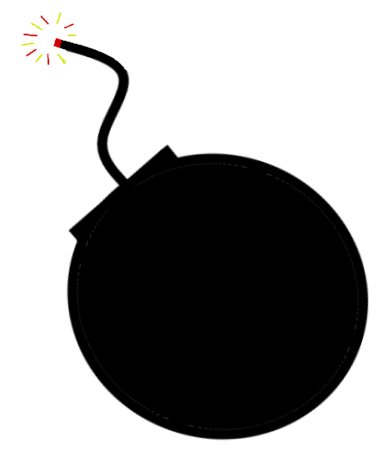
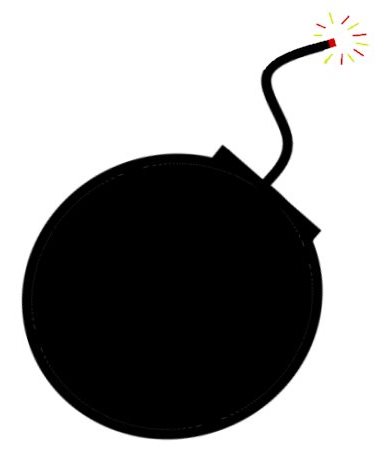 Although often played as a Children's game, Go Boom can also be a fun pastime for card players of all ages. In fact, Go Boom is a great game for an introduction the concepts explored in many trick taking games.
Although often played as a Children's game, Go Boom can also be a fun pastime for card players of all ages. In fact, Go Boom is a great game for an introduction the concepts explored in many trick taking games.
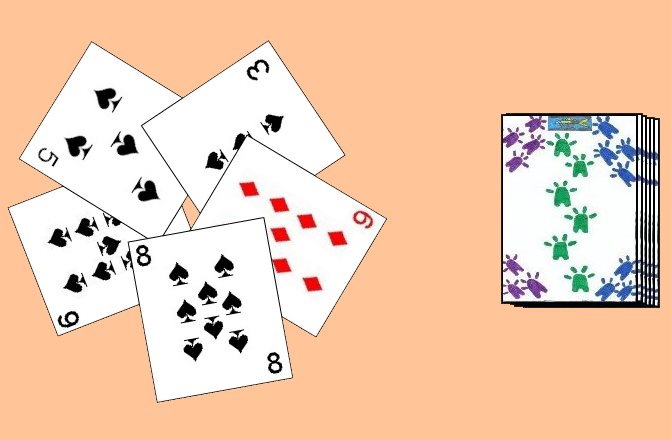 Play begins with the player to the dealer's immediate left. He may select any card from his hand and play it face-up to the table. Each other player, in a clockwise rotation then plays one card to the table. Each round of cards played to the center of the table is known as a trick. A player must play a card of either the same suit as the card first played to start the trick or a card of the exact same denomination as the card played to start the trick. If a player does not have such a card in hand, he must draw from the stock until he draws a card he is able to play. If the stock runs out of cards and a player would normally need to draw, he simply states "pass" and does not play to the trick. After each player has had the opportunity to play to the trick, the winner is determined. The highest card played to the trick wins the trick. If two cards of the same denomination have been played to the trick, the first of the two cards played wins the trick. After the winner of the trick is determined, the trick is set aside, it's cards not used again during the current hand. The winner of that trick then plays any card remaining in his had to begin the next trick which is played in the same manner.
Play begins with the player to the dealer's immediate left. He may select any card from his hand and play it face-up to the table. Each other player, in a clockwise rotation then plays one card to the table. Each round of cards played to the center of the table is known as a trick. A player must play a card of either the same suit as the card first played to start the trick or a card of the exact same denomination as the card played to start the trick. If a player does not have such a card in hand, he must draw from the stock until he draws a card he is able to play. If the stock runs out of cards and a player would normally need to draw, he simply states "pass" and does not play to the trick. After each player has had the opportunity to play to the trick, the winner is determined. The highest card played to the trick wins the trick. If two cards of the same denomination have been played to the trick, the first of the two cards played wins the trick. After the winner of the trick is determined, the trick is set aside, it's cards not used again during the current hand. The winner of that trick then plays any card remaining in his had to begin the next trick which is played in the same manner.
 Enflé: Enflé is another fun game which combines the winning of tricks with the attempt to be the first player to run out of cards. This game also goes by the names Schwellen and Rolling Stone.
Enflé: Enflé is another fun game which combines the winning of tricks with the attempt to be the first player to run out of cards. This game also goes by the names Schwellen and Rolling Stone.

 For the second and subsequent tricks, the winner of the previous trick begins play by selecting any card of choice from his hand and placing it face-up in the middle of the table to start that trick. On the second trick, this trick will be started by the player of the Ace of Spades from the previous trick, since that would be
the winning card from the first trick. After the leader to the trick plays the first card the turn rotates in a clockwise direction from that lead player. If a player has one or more cards of the suit originally led to the trick, he so must play a card of that suit to the trick, face-up. However if the player does not have a card of that suit, he can play any card from his hand to the trick (called tochoo), also face-up. In the event a player does play a card of a different suit, play to that trick immediately halts. Whichever player played the highest card of the suit originally led to that trick then takes all cards which have been led to the trick into his hand (including the card of a different suit). Note that, because play to that trick was halted, not every player may have played a card to that trick. The player of that highest card (the winner of that trick), then begins play to the next trick, leading any card of choice from his hand. If all players managed to play a card of the suit originally led to the trick, no player is required to take those cards into his hand, and the cards from that trick are added face-down to the waste pile. The player who played the highest card to that trick is considered the winner of the trick and begins play to the next trick, leading any card of choice from his hand.
For the second and subsequent tricks, the winner of the previous trick begins play by selecting any card of choice from his hand and placing it face-up in the middle of the table to start that trick. On the second trick, this trick will be started by the player of the Ace of Spades from the previous trick, since that would be
the winning card from the first trick. After the leader to the trick plays the first card the turn rotates in a clockwise direction from that lead player. If a player has one or more cards of the suit originally led to the trick, he so must play a card of that suit to the trick, face-up. However if the player does not have a card of that suit, he can play any card from his hand to the trick (called tochoo), also face-up. In the event a player does play a card of a different suit, play to that trick immediately halts. Whichever player played the highest card of the suit originally led to that trick then takes all cards which have been led to the trick into his hand (including the card of a different suit). Note that, because play to that trick was halted, not every player may have played a card to that trick. The player of that highest card (the winner of that trick), then begins play to the next trick, leading any card of choice from his hand. If all players managed to play a card of the suit originally led to the trick, no player is required to take those cards into his hand, and the cards from that trick are added face-down to the waste pile. The player who played the highest card to that trick is considered the winner of the trick and begins play to the next trick, leading any card of choice from his hand.
 Determination of seating positions and the first dealer can be performed using a variety of methods, with draw for high card a common method. Players would each randomly draw a card from the shuffled deck, and take seats at the table in order of cards drawn, from highest ranking to lowest. Any players drawing cards of equal rank would discard those cards and draw again, continuing to redraw if drawing a card that has already been previously drawn by another participant. The player drawing the highest card of all is set as the first dealer. After each hand the role of dealer rotates around the table in a counter-clockwise direction.
Determination of seating positions and the first dealer can be performed using a variety of methods, with draw for high card a common method. Players would each randomly draw a card from the shuffled deck, and take seats at the table in order of cards drawn, from highest ranking to lowest. Any players drawing cards of equal rank would discard those cards and draw again, continuing to redraw if drawing a card that has already been previously drawn by another participant. The player drawing the highest card of all is set as the first dealer. After each hand the role of dealer rotates around the table in a counter-clockwise direction.

 If a player is unable to play a card to the trick and there are no more cards in the stock to draw, that player simply skips his turn, with play advancing to the next player in turn. However, after the other players have played to the trick, the player unable to play to that trick must take all the cards from the trick and add those cards to his current hand. If there were two or more players unable to play a card to that trick, after the trick has been completed by the other players,
the players unable to play a card to the trick must then, each in turn, starting with the first player unable to play a card to the trick, take any one card from that trick. This continues in a clockwise rotation amongst all the players unable to play to the trick until there are no cards left in the trick. The winner of that last trick, then, as normal, leads the first card to start the next trick.
If a player is unable to play a card to the trick and there are no more cards in the stock to draw, that player simply skips his turn, with play advancing to the next player in turn. However, after the other players have played to the trick, the player unable to play to that trick must take all the cards from the trick and add those cards to his current hand. If there were two or more players unable to play a card to that trick, after the trick has been completed by the other players,
the players unable to play a card to the trick must then, each in turn, starting with the first player unable to play a card to the trick, take any one card from that trick. This continues in a clockwise rotation amongst all the players unable to play to the trick until there are no cards left in the trick. The winner of that last trick, then, as normal, leads the first card to start the next trick.